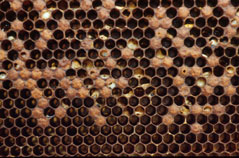An adult female, V. destructor is elliptical in shape with a width of 1.5 mm, a length of 1.0 mm, and four pairs of legs. Mature female mites are brown, dark brown, or cordovan (photo A). During immature stages, the bodies of V. destructor are light and translucent, but those attributes tend to disappear on adult hosts. Usually, there are no obvious symptoms at low levels of infestation. As the mite population increases, a suite of symptoms, collectively designated parasitic mite syndrome, becomes apparent. Initially, adult workers with damaged wings are seen (photo B). This damage is a result of DWV (deformed wing virus), which is introduced either directly or indirectly to the developing bee by the mite.
 |
| Photo C. Deteriorating brood typical with high levels of V. destructor. |
As the infestation rate increases, more damaged workers are seen and otherwise healthy looking bees may be seen crawling in front of the hive, unable to fly. This condition is also caused by a virus. Finally, the brood begins to deteriorate, appearing to be infected with a variety of pathogens (photo C). Although these brood symptoms superficially resemble American and European foulbrood, the causative organisms of those diseases have not been identified in the deteriorating brood and treatment with antibiotics does not eliminate the condition. As the syndrome progresses, the worker death rate exceeds the birth rate, and most new worker bees that do emerge are seriously impaired. As a result, the colony’s population begins a rapid decline. From the time that a colony first exhibits brood symptoms until its total collapse can be as little as three weeks.
